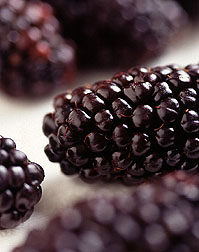This page has been archived and is being provided for reference purposes only. The page is no longer being updated, and therefore, links on the page may be invalid.
|
|
Black Butte Is Heavyweight Among BlackberriesBy Kathryn Barry StelljesJuly 23, 1997 CORVALLIS, Ore., July 23—The world's largest blackberry should be ready by next spring for planting by home gardeners, pick-your-own operations and commercial growers in parts of the West and South. Dubbed "Black Butte," the berry could start showing up in grocery store produce sections nationwide in the summer of 2000. "Black Butte's fruit is huge and its uniform shape and nice color are visually appealing," said geneticist Chad E. Finn, who works for the Agricultural Research Service, chief research agency of the U.S. Department of Agriculture. Finn developed the new berry in cooperation with the Oregon Agricultural Experiment Station here. Finn is at the ARS Horticultural Crops Research Lab, also in Corvallis. Black Butte berries average 1 inch in diameter and 2 inches long. Individual berries weigh more than two-fifths of an ounce--almost twice the size of other varieties of fresh blackberries. "Similar-size berries may grow on vines used for research or breeding, but this is the only named, publicly released cultivar with berries this large," said Finn. The new variety has thorny, trailing vines. Almost all of the popular trailing blackberry varieties were developed at the ARS lab in Corvallis. Oregon is the leading producer of these berries. Trailing berries are usually soft-skinned and best suited for processing into jams, juices and other berry products. But Black Butte has firmer fruit that's suited for the fresh market, said Finn. Most of the country's fresh blackberries are produced on varieties developed in the eastern states. These "erect" or "semi-erect" types, grown throughout the East, Northwest and California, withstand cold winter temperatures better than trailing varieties. More important, the vines bear firm berries that can handle the rigors of shipping. Black Butte's berries ripen in late June, four to six weeks earlier than the thornless, semi-erect varieties. The new berry vines have been tested in Oregon, Arkansas, California, North Carolina, Washington, Canada, England and New Zealand, said Finn. Black Butte should grow well in areas where winter temperatures stay above 10 degrees Fahrenheit. Blackberries are low in fat and sodium and a good source of fiber, potassium and vitamins A and C. Scientific contact: Chad E. Finn, USDA-ARS Horticultural Crops Research Laboratory, 3420 NW Orchard Ave., Corvallis, OR 97330. Phone (541) 750-8760 or 750-8759, fax 750-8764, finnc@bcc.orst.edu. |

